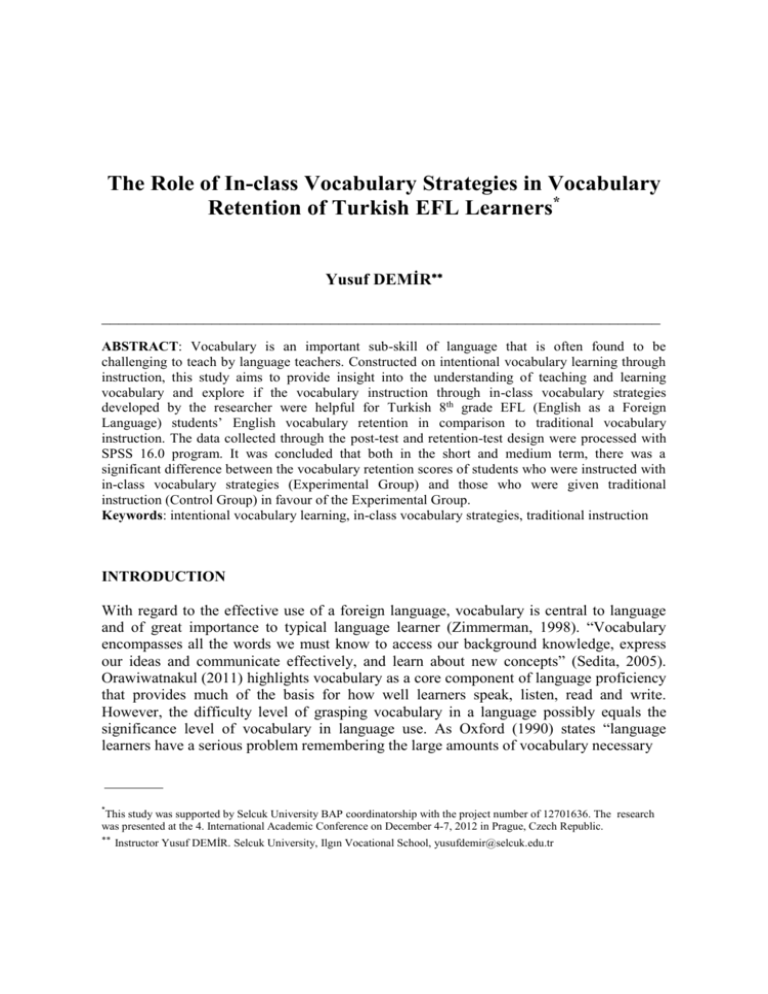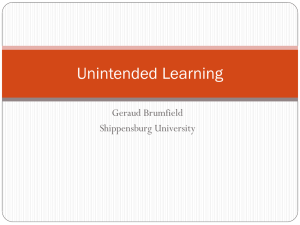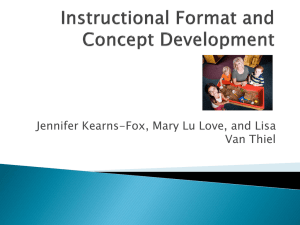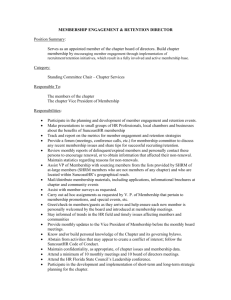Article - Php dersleri
advertisement

The Role of In-class Vocabulary Strategies in Vocabulary Retention of Turkish EFL Learners* Yusuf DEMİR __________________________________________________________________ ABSTRACT: Vocabulary is an important sub-skill of language that is often found to be challenging to teach by language teachers. Constructed on intentional vocabulary learning through instruction, this study aims to provide insight into the understanding of teaching and learning vocabulary and explore if the vocabulary instruction through in-class vocabulary strategies developed by the researcher were helpful for Turkish 8th grade EFL (English as a Foreign Language) students’ English vocabulary retention in comparison to traditional vocabulary instruction. The data collected through the post-test and retention-test design were processed with SPSS 16.0 program. It was concluded that both in the short and medium term, there was a significant difference between the vocabulary retention scores of students who were instructed with in-class vocabulary strategies (Experimental Group) and those who were given traditional instruction (Control Group) in favour of the Experimental Group. Keywords: intentional vocabulary learning, in-class vocabulary strategies, traditional instruction INTRODUCTION With regard to the effective use of a foreign language, vocabulary is central to language and of great importance to typical language learner (Zimmerman, 1998). “Vocabulary encompasses all the words we must know to access our background knowledge, express our ideas and communicate effectively, and learn about new concepts” (Sedita, 2005). Orawiwatnakul (2011) highlights vocabulary as a core component of language proficiency that provides much of the basis for how well learners speak, listen, read and write. However, the difficulty level of grasping vocabulary in a language possibly equals the significance level of vocabulary in language use. As Oxford (1990) states “language learners have a serious problem remembering the large amounts of vocabulary necessary *This study was supported by Selcuk University BAP coordinatorship with the project number of 12701636. The research was presented at the 4. International Academic Conference on December 4-7, 2012 in Prague, Czech Republic. Instructor Yusuf DEMİR. Selcuk University, Ilgın Vocational School, yusufdemir@selcuk.edu.tr to achieve fluency”. Hence, the role of vocabulary is determinative in language classes in terms of enhancing learners’ use of L2 fluently. Incidental Versus Intentional Vocabulary Learning Yali (2010) states that in L2 lexical teaching and learning, there are two types of vocabulary learning: incidental learning and intentional learning and Read (2004) notes that in studies on L2 vocabulary learning, a distinction had long been made between incidental and intentional learning. “In vocabulary acquisition, incidental learning is broadly defined as the learning of vocabulary as a by-product of any activity not explicitly geared towards vocabulary learning” (Rieder, 2003). On the other hand, intentional vocabulary learning is defined as any activity that aims at committing lexical information to memory (Hulstijn, 2001; cited in Choo, 2012). According to Ahmad (2011), incidental vocabulary learning involves learners’ ability to guess the meaning of new words from the contextual clues. Correspondingly, in his book which includes the activities of teaching vocabulary in context, Demirel (2007) suggests that vocabulary should be taught only in the context of real situations so that meaning will be clarified and reinforced. In his review of 144 studies, Krashen (1981; cited in Rahmani and Nasri, 2013) made the inference that incidental acquisition of vocabulary occurs through the operation of his Input hypothesis, with reading providing the comprehensible input that leads naturally to acquisition. What’s more, Anuthama (2010) signified that the incidental learning of vocabulary through extensive reading can benefit language curricula and learners at all levels. It is commonly agreed that incidental vocabulary learning has such advantages as guessing word meaning from the context, promoting deeper mental processing (Ahmad, 2011) and facilitating retention (Huchin & Bloch, 1993; Nation, 1990; Schouten-Van Parreren, 1992). However, incidental vocabulary instruction also has some limitations in some aspects. In the first place, Nation (1990) contends that successful guessing in context occurs when about 95% of the lexical items in a text are already known. At this point, especially for students at elementary level, lack of sufficient vocabulary knowledge may preclude their guessing from the context. Secondly, as Yali (2010) notes, inferring word meaning is an error-prone process. Unless the context is very constrained, which is a relatively rare occurrence, or unless there is a relationship with a known word identifiable on the basis of form and supported by context, there is little chance of guessing the meaning correctly (Kelly, 1990). Last but not least, inferring word meaning is a very gradual and complex process that may not necessarily result in longterm retention especially when students regard the words to be guessed as temporary supporting components of the text. Contrary to incidental vocabulary learning that centers mainly on the context, the main focus of intentional vocabulary learning is the vocabulary itself. Any conscious strategy may be employed with the purpose of acquiring vocabulary in intentional learning. According to Anuthama (2010) intentional learning through instruction significantly contributes to vocabulary development and Coady (1997) emphasizes the necessity of intentional vocabulary instruction as a prerequisite by asking “how beginners could learn enough words to learn vocabulary through extensive reading when they do not know enough words to read well”. On the other hand, Ahmad (2011) puts forward the idea that intentional vocabulary learning based on synonyms, antonyms, word substitution, multiple choice, scrambled words and crossword puzzles, regardless of context, is not so effective, because learners are more prone to rote learning and they cram the meaning of the new words without undergoing cognitive process. As a consequence, “focusing on incidental learning alone is not sufficient” (Nation, 1990) and neither of the two learning types, taken by itself seems enough for vocabulary acquisition. Haynes (1993) is also of the opinion that for fast vocabulary expansion, incidental vocabulary instruction should be accompanied with intentional learning. Yali’s (2010) case study corroborates this conception yielding the result that combination of the incidental and intentional learning instruction leads to greater vocabulary gains and better retention. Within this context, Demirel (2007) incorporates the elements of incidental learning with those of intentional learning instruction as shown in the steps of teaching vocabulary below: 1.Lead-in: The teacher establishes a context in which to teach the word. 2.Convey meaning: The teacher conveys the meaning of a word by using the several techniques (including guessing the meaning of the word) 3.Repetition of the word 4.Verification: This can be done by asking a question in which the students’ response will show whether or not they have understood the meaning. 5.Use: Students try to use the word in a context with the help of a teacher. 6.Model sentence: A model sentence using the word should either be written on the black board or dictated to the students. Does traditional vocabulary instruction work? Traditional vocabulary instruction heavily relies on and involves the use of word definitions, some combination of looking them up, writing them down and memorizing them. (Technical Report of University of Illinois Center for the Study of Reading, 1988; Kang, 1995; Cohen & Byrnes, 2007). In such an instruction, students are given a list of words, they copy the definition from a dictionary, and write sentences for each word based on the information. This is often the case in foreign language classes, also in classrooms throughout the United States (Sargent and Onley, 2006). On the other hand, we should question whether these superficial activities are enough to equip students with necessary vocabulary knowledge and lead them to a deeper word processing and long-term vocabulary retention. Through the research by Martinez-Lage (1997), Constantinescu (2007) and Phillips et al. (2008), it was understood that this type of vocabulary instruction is not the most efficient way of teaching vocabulary. According to Kang (1995), the reason for criticisms towards the traditional vocabulary instruction is the failure of definitions alone to provide adequate context. Regarding explicit vocabulary instruction, Taylor et al. (2009) believe that explicit teaching is a way of teaching vocabulary that has a clear pedagogic component and involves the teacher, who must go beyond naming or providing a long list of words to be learned by students in a unit of study and instead provide appropriate instruction to facilitate learning. At this point, explicit vocabulary instruction also necessitates active involvement of students in various vocabulary activities and doesn’t solely rely on traditional instruction. Rather, in Nation and Newton’s (1997) words, explicit instruction includes the use of vocabulary exercises of various types and is “particularly important for struggling readers” (Biemiller, 2003). What’s more, numerous studies have documented the positive impact of direct, explicit vocabulary instruction on both immediate word learning and longer-term reading comprehension (Baker, Kame’enui, & Simmons, 1995; Beck, McKeown, & Kucan, 2002; Biemiller, 2004; Marzano, 2004; cited in Feldman & Kinsella, 2005 ). In the extensive literature reviewed, it was observed that vocabulary-related research has largely focused on incidental learning, implicit instruction and psychology of vocabulary acquisition. However, studies that have investigated intentional vocabulary learning with traditional classroom activities in practice are rare. Within this context, this study seeks to explore whether in-class vocabulary strategies overwhelm traditional instruction and corroborate the hypothesis that traditional vocabulary instruction is not an effective way of teaching vocabulary. For these purposes, the following research questions were asked: 1. Do the in-class vocabulary strategies developed by the researcher provide better vocabulary retention than traditional vocabulary instruction? 2. Is there a significant difference between the vocabulary retention scores of experimental and control groups both in the short and medium term? METHODOLOGY Participants This study was carried out with 129 students at 8th grade attending to four different classes, all of whom were being educated in public primary schools in Konya. The experimental group consisted of 66 students from two different classes and the control group was comprised of 63 students from two classes. There was a fair distribution of groups in terms of success and gender distribution. In the process of equating the control and experimental groups, observations of the students’ English teachers were utilized and the average English exam scores of the classes were taken into consideration. Table-1 presents the gender distribution of the groups. Table 1. Gender Distribution of the Groups Gender Class A-C Class B-D (Experimental Group) (Control Group) Male 34 31 Female 32 32 Materials The target words taught to the groups were in a newspaper cutting. The newspaper cutting used in this research (See Appendix 1) was taken from a local English newspaper. Several archives of British and American news were scanned in order to provide the article that matches best with the students’ level and interests. Rather than making use of a text regarding politics, editorials, news of a crime, burglary etc., an easy-to-understand, interesting, illustrated news article was chosen appropriate for the students’ age group. Another reason for the selection of this newspaper clipping was that it includes vocabulary which meets such criteria as importance and utility, instructional potential and conceptual understanding (Beck et al., 2002). It is worth noting that the little cellists in the news photo are a bit younger than the subjects but very young successful instrument players are always there to draw heavy attention of teenagers. What’s more, considering Willows’ (1978) report that pictures had larger effects for younger children and for those who were less-skilled readers and Levin et al.’s (1987) statement that “for readers who struggle, pictures operate beyond the decoration function, serving as a tool to create or confirm understanding”, the newspaper cutting used in this study included pictures with the purpose of providing students with a concrete understanding of the text. This newspaper cutting reported the story of how the young children in Pulborough learned to play the instrument called cello and pictures of the two children with cellos in their hands. Instruments With the purpose of measuring vocabulary retention of the two groups at two different times; consisting of thirty target words chosen from the clipping, the same vocabulary test that was used as both post-test and retention-test (See Appendix 2) was taken by both EG and CG one day and ten days after the instruction. Data Analysis In order to determine group differences in terms of vocabulary retention, independent samples t-tests were employed. SPSS 16.0 package was used in the analyses of the data collected from post-test and retention test. Procedure The same thirty target words selected from the newspaper cutting were instructed to EG and CG seperately. The process of the instructions are detailed below. Implementation of traditional vocabulary instruction to the Control Group Throughout the process of teaching the target words in the news article to the control group, the teacher’s instruction included the essentials of traditional vocabulary teaching as described by Cohen and Byrnes (2007) in isolation without context. As for the steps, the teacher followed teacher-directed interaction and negotiation suggested by Lee (2003), which is based on psycholinguistic principles of word learning that capture the multifaceted view of word knowledge as sequenced below: - see the word (visual or spelling representation), - hear the word (teacher modeled pronunciation), - understand the word (definitional meaning and part of speech, negotiation, explanation, and elaboration of meaning in context and relation with other words), - say the word (repetition), and - use the word in context (writing). The following steps were followed by the teacher during the instruction. Step 1: the thirty target words in the news article were written on the board. (see the word) Step 2: the teacher modeled pronunciation of the target vocabulary twice. (hear the word) Step 3: the CG students were provided with the meanings of the words in Turkish. (understand the word) Step 4: the teacher had the students repeat the target words after the articulation of the teacher twice. (say the word) Step 5: the teacher had the students write the target words on their notebooks. In order to avoid context and provide a pure mechanical traditional instruction, the final step of Lee’s (2003) systematical instruction model was omitted, i.e. students were not made to use the words in context, so that traditional instruction was not capitulated. The whole session lasted fifteen minutes. Implementation of in-class vocabulary strategies to the Experimental Group Step 1: As the lead-in activity, the teacher asked the students to circle words in the heading that they did not comprehend, guess their meaning by looking at the text’s picture and comment on what the story could be about. Students were also guided to find the figure of speech in the heading ‘Little kids say cello to a big musical future’. Step 2: the teacher made EG students cut out the thirty target words from the newspaper clipping, agglutinate or stick them on their notebooks and use each of them in a sentence. Step 3: Echevarria et al. (2008) explain that “English learners make more rapid progress in mastering content objectives when they are provided with multiple opportunities to practice with hand-on materials and/or manipulatives” and this third step is educatory in that it is intended to lead students to discover both individually and within a group, which is to provide students with more interactive learning experience and a growing mind. At the third step, EG students were instructed to discover a new word within the body of each of the target words by using a dictionary. Each discovery was given 1 point and the first three students reaching 5 points was appointed a reinforcement (a toy, a stickers with different shapes and pictures, a symbolic star-shaped sticker would often work. Instead, the research group was promised an additional 20 points as a part of the verbal scoring of the term, since teenage students couldn’t be expected to come round to a small starfish). Then, they were required to write on the board those discovered words under the heading of ‘discovered word’. Example : Target word Opportunity Discovered word port (1 point) Step 4: Ultimately, EG students were made to invent new English words or names by using the initials of the 30 target words acrostically. A similar scoring could be applied for this activity, too. Example : Chin Adult Thrill +____________ CAT or ACT (1 point) After instructing both of the groups; (a) in order to see the effects of the instructions on vocabulary retention in the short term, the post-test was applied to both groups one day after the instructions. (b) in order to see the effects of the instructions on vocabulary retention in the medium term, the same post-test, also used as the retention-test was applied to both groups again ten days after the instructions. In the study, both groups were instructed for not any longer than half of a course time. Only one session was applied for each of the groups. Involving children longer in the activities with multi-sessions could provide more proof in line with the study. FINDINGS In order to find out (1) if the in-class vocabulary strategies developed by the researcher provide better vocabulary retention than traditional vocabulary instruction and (2) if there is a significant difference between the vocabulary retention scores of experimental and control groups both in the short and medium term, the results of the two IndependentSamples T-tests carried out one and ten days after the instructions are depicted below. In the scoring of post-test and retention-test, each missing or wrong answer was scored ‘0’ and each correct answer was given ‘1’. So, the maximum mean value of a group is supposed to be 30. Table 3. Independent-Samples T-test comparing vocabulary retention of EG and CG one day after the instructions (post-test) Group N Mean Sd. t df Sig.(2-tailed) EG 66 23.3571 3.12306 3.622 127 0.001 CG 63 **p<0.01 15.4615 2.77461 T-test results above indicate significant differences between the overall responses of EG and CG to the post-test one day after the instructions (p<0.05). From the mean values of the groups ( EG > CG) it is also understood that EG retained much more vocabulary as a result of being exposed to the in-class vocabulary teaching strategies. Ten days after the instructions, the same post-test which was also used as retention test was applied to both EG and CG once more in order to find out if the groups have still retained the same vocabulary. Table 4. Independent-Samples T-test comparing vocabulary retention of EG and CG ten days after the instructions (retention test) Group N Mean Sd. t df Sig.(2-tailed) EG 66 19.1786 4.28179 3.005 CG **p<0.01 63 10.6538 127 0.004 3.72562 T-test above indicates that there is still a significant difference (p=0.004<0.05) in the vocabulary retention of two groups in favour of EG ( EG > CG), but mean values of both of the groups pertaining to two different times make clear that ( Ten days after < one day after) as time passed, students of both groups forgot some of the vocabulary they had remembered. CONCLUSION AND IMPLICATIONS Built on intentional vocabulary learning through two different instruction types, this study basically intended to compare the efficacy of implementing several in-class vocabulary teaching strategies to the traditional vocabulary instruction. The major conclusion made from this study is that involving students in inventive and interesting in-class strategies supported by hands-on activities is an effective way of teaching vocabulary. It was observed in the comparisons made one day after the instruction (post-test) between control and experimental groups that EG students retained more vocabulary as a result of being instructed with in-class vocabulary strategies. This is probably because EG students did not blindly stick to only one particular way of learning vocabulary, as corroborated by Tabtimsai (2003; cited in Orawiwatnakul, 2011) indicating that vocabulary learning techniques can help to improve students’ learning outcome. On the other hand, CG students retained much less vocabulary as a result of being instructed with definitionbased, traditional, plain instruction by the teacher. Moreover, upon applying the same vocabulary test (retention test) to both groups ten days after the instruction, although both of the groups were negatively affected by ten days of interval in terms of retention of target vocabulary, it was understood that EG students retained more vocabulary than CG, which can again be attributed to their being taught with newly introduced in-class vocabulary strategies. Zahedi and Abdi (2012) explored that imagery strategy outperformed direct instruction model in terms of vocabulary mastery of Persian lower-intermediate students. Moreover, in a classroom research made by Sargent and Olney (2006), it was concluded that traditional didactic manner did not empower the students to learn the vocabulary words. Furthermore, a report by Southeastern Louisiana University (Undated) compared traditional instruction with multi-sensory vocabulary instruction. The results revealed that students were more successful with using vocabulary words correctly after one week of multi-sensory vocabulary instruction and less successful with using vocabulary words correctly after one week of traditional vocabulary instruction. Last but not least, the studies of Erdemir (2005) and Yonek (2008) respectively made clear that multimediaenhanced instruction proved to be more effective on second language learners’ vocabulary recall and production than traditional instruction and that rich instruction (involving students in both definitional and contextual information, multiple exposures and active or deep processing of each word) is more effective than traditional instruction (dictionary definitions, matching activities, cloze sentence activities and sentence writing) in helping students to deepen word knowledge and utilize newly learned words in complex literacy acts such as writing. To sum up, in a great body of research it was observed that traditional instruction didn’t lead to a better vocabulary acquisition when compared to several instruction models and strategies. Possibly, as Phillips et al. (2008) state, the reason why traditional instructions are ineffective is that “such methods utilize the lowest levels of cognitive processing from the perspective of Benjamin Bloom’s taxonomy of Thinking (1956), so they are highly unlikely to lead to true understanding, learning or transfer to new situations”. Although this study was built on a limited set of vocabulary, it does yield some pedagogical implications. Now that “looking up words or committing definitions to memory leads at best to a superficial understanding and rapid forgetting of words” (Greenwood, 2002) , and does not often lead to any deeper mental processing of words, it is no use insisting solely on traditional instruction. Rather than implementing only one strategy in teaching vocabulary, it is strongly recommended that fundamentals of incidental and intentional vocabulary learning should be blended in language classes. To exemplify, an ideal vocabulary course should include the use of multimedia and strategies addressing senses, guessing from context, repeated exposure, modeling of pronunciation, oral repetition, having students form sentences with target vocabulary, and even copying of the definition when needed. What’s more, as exemplified in this research, vocabulary teaching should include some visual representations accompanying texts especially when focusing on young language learners in order to facilitate guessing words. As was reflected in Mayer’s (1999) study, words and pictures together produced better recall and transfer than either did alone. For this reason, any printed course material (textbooks, handouts, newspaper clippings etc.) specifically aimed to enrich students’ vocabulary should also include visuals related with the texts, considering Paivio’s (1991) dual coding theory which states the human cognition consists of two systems that process knowledge simultaneously, one processing the nonverbal objects (imagery) and one dealing with language (verbal). For further research, the efficacy of combining incidental and intentional learning on vocabulary acquisition may be investigated and compared to several methods and strategies of teaching vocabulary, which have previously overwhelmed traditional instruction. Besides, the role of extensive reading in guessing word meaning from context might be a compelling study as well. REFERENCES Ahmad, J. (2011). Intentional vs. Incidental Vocabulary Learning. Interdisciplinary Journal of Contemporary Research in Business, 3(5), 67-75 Anuthama, B. (2010). Strategies for Teaching Vocabulary. Journal of NELTA, 15(1-2), 10-15. Baker, S. K., Simmons, D. C., & Kameenui, E. J. (1995). Vocabulary Acquisition: Synthesis of the Research. (Tech. Rep. No. 13). Eugene: University of Oregon, National Center to Improve the Tools of Educators. Beck, I.L., McKeown, M.G., & Kucan, L. (2002). Bringing words to life: Robust vocabulary instruction. New York: Guilford Press. Biemiller, A. (2003). Vocabulary: Needed if more children are to read well. Reading Psychology, 24(3-4), 323-335. Biemiller, A. (2004). Teaching Vocabulary in the Primary Grades: Vocabulary Instruction Needed, In J.F. Baumann & E.J. Kame’enui (Eds.), Vocabulary instruction: From research to practice (pp. 159–176). New York: Guilford Press. Bloom, B.S. (1956). Taxonomy of Educational Objectives, Handbook I: The Cognitive Domain. New York: David McKay Co Inc. Choo, L.B., Tan, D.A.L., Pandian, A. (2012). Language Learning Approaches: A Review of Research on Explicit and Implicit Learning in Vocabulary Acquisition. Procedia Social and Behavioral Sciences, 55, 852-860. Coady, J., & Huckin, T. (Eds.). (1997). Second language vocabulary acquisition: A rationale for pedagogy. Cambridge: Cambridge University Press. Cohen, L., Byrnes, K. (2007). Engaging Children with Useful Words: Vocabulary Instruction in a Third Grade Classroom. Reading Horizons Journal, 47(4), 271-293. Constantinescu, A. I. (2007). Using technology to assist in vocabulary acquisition and reading comprehension. The Internet TESL Journal, 13(2). Retrieved February 28, 2013 from http://iteslj.org/Articles/Constantinescu-Vocabulary.html. Demirel, Ö. (2007). ELT Methodology. Ankara: Pegema. Echevarría, J., Vogt, M.E., & Short D.J. (2008). Making content comprehensible for English learners: The SIOP model. Pearson. Erdemir, A. (2008). Multimedia-Enhanced Versus Traditional Vocabulary Instuction: Short-term and Long-term Effects On Second Language Learners’ Receptive and Productive Knowledge. Department of Linguistics in the Graduate School, MA Thesis, Southern Illinois University Carbondale Feldman, K., Kinsella, K. (2005). Narrowing the Language Gap: The Case for Explicit Vocabulary Instruction. New York: Scholastic Inc. Greenwood, S. C. (2002). Making words matter: Vocabulary study in the content areas. The Clearing House, 75, 258-263. Haynes, M. (1993). Patterns and perils of guessing in second language reading. In T. Huckin, M. Haynes & J. Coady (eds.), Second Language Reading and Vocabulary Learning. Norwood, N. J. : Ablex Publishing Corporation. Huchin, T. & Bloch, J. (1993). Strategies for inferring word meaning in context: A cognitive model. In T. Hucin, M. Haynes & J. Coady (eds.), Second Language Reading and Vocabulary Learning, 153-176. Hulstijn, J. (2001). Intentional and incidental second language vocabulary learning: A reappraisal of elaboration, rehearsal and automaticity. In P. Robinson (Ed.), Cognition and second language instruction. Cambridge, UK: Cambridge University Press. Kang, S. (1995). The effects of a context-embedded approach to second-language vocabulary learning. System, 23(1), 43-55. Kelly, P. (1990). Guessing: No substitute for systematic learning of lexis. System, 18, 199207. Krashen, S. (1981). Second language acquisition and second language learning. Oxford, England: Pergamon Press. Lee, S.H. (2003). ESL learners’ vocabulary use in writing and the effects of explicit vocabulary instruction. System, 31, 537–561. Levin, J.R., Anglin, G.J., Carney, R.N. (1987). On empirically validating functions of pictures in prose. In D.M. Willows & H.A. Houghton (Eds.), The psychology of illustration: Vol.I (pp. 51-78). New York: Springer-Verlag. Martinez-Lage, A. (1997). Hypermedia technology for teaching reading. In M. Bush & R. Terry (Eds.), Technology enhanced language learning (pp. 121-163). Lincolnwood, IL: National Textbook Company. Marzano, R.J. (2004). The developing vision of vocabulary instruction. In J.F. Baumann & E.J. Kame’enui (Eds.), Vocabulary instruction: From research to practice (pp. 159– 176). New York: Guilford Press. Mayer, R.E., (1999). Research-based principles for the design of instructional messages: The case of multimedia explanations, Document design, 1, 7. Nagy, W.E. (1988). Vocabulary Instruction and Reading Comprenesion. (Technical Report No. 431). University of Illinois Center for the Study of Reading. Nam, J. (2010). Linking Research and Practice: Effective Strategies for Teaching Vocabulary in the ESL Classroom. TESL CANADA JOURNAL, 28(1), 127-135. Nation, I. S. P. (1990). Teaching and Learning Vocabulary. New York: Newbury House. Nation, P., Newton, J. (1997). Teaching Vocabulary. In James Coady and Thomas Huckin (Eds.) Second Language Vocabulary Acquisition. Cambridge Applied Linguistics. Cambridge: Cambridge University Press. pp.238-253. Orawiwatnakul, W. (2011). Impacts Of Vocabulary Acquisition Techniques Instruction On Students' Learning. Journal of College Teaching and Learning, 8(1), 47-53. Oxford, R. (1990). Language learning strategies: What every teacher should know. New York: Newbury House. Phillips, D.C.K., Foote, C.J., Harper, L.J. (2008). Strategies For Effective Vocabulary Instruction. Reading Improvement, 45(2), 62-68. Rahmani, F., Nasri, N. (2013). The effects of instruction type on vocabulary learning: A psycholinguistics study. Procedia - Social and Behavioral Sciences, 70, 787-794. Rieder, A. (2003). Implicit and explicit learning in incidental vocabulary acquisition. Paper presented at the EUROSLA Conference, Edinburgh. Sargent, A., Olney, R. (2006). A Case Study of Vocabulary Instruction for High School Students. ICCTE JOURNAL, 1(2). Schouten-Van Parreren, C. (1992). Individual differences in vocabulary acquisition: A qualitative experiment in the first phase of secondary education. In P. Arnaud & H. Bejoint (eds.), Vocabulary and Applied Linguistics. Basingstoke: Macmillan. 94-101. Sedita, J. (2005). Effective Vocabulary Instruction. Insights on Learning Disabilities, 2(1), 33-45. Southeastern Louisiana University (Undated). Traditional Vs. Multi-sensory Vocabulary Instruction-Which Instructional Strategy Is More Effective for Enhancing Dyslexic & Low Performing Reader’s Vocabulary? Retrieved February 26, 2013, http://www2.southeastern.edu/orgs/NCATE/ncate/LASS/ExhibitLASS1_6.pdf from Tabtimsai, K. (2003) The development of vocabulary learning strategies exercises for mathayomsuksa three students of Thamakavittthayakom School, Thamaka, Kanchanaburi. MA Thesis, Silapakorn University Taylor, D.B., Mraz, M., Nichols, W.D., Rickelman, R.J. & Wood, K.D. (2009). Using Explicit Instruction to Promote Vocabulary Learning for Struggling Readers. Reading&Writing Quarterly: Overcoming Learning Difficulties, 25(2-3), 205-220. Willows, D.M. (1978). A picture is not always worth a thousand words: Pictures as distractors in reading. Journal of Educational Psychology, 70, 255-262. Yali, G. (2010). L2 Vocabulary Acquisition Through Reading—Incidental Learning and Intentional Learning. Chinese Journal of Applied Linguistics, 33(1), 74-93. Yonek, L.M. (2008). The Effects of Rich Vocabulary Instruction on Students’ Expository Writing. PhD Dissertation, Graduate Faculty of School of Education University of Pittsburgh. Zahedia, Y., Abdi, M. (2012). The impact of imagery strategy on EFL learners’ vocabulary learning. Procedia - Social and Behavioral Sciences, 69, 2264-2272. Zimmerman, C.B. (1998). Historical trends in second language vocabulary instruction. In J. Coady and T. Huckin (Eds.), second language vocabulary acquisition: A rationale for pedagogy (pp. 5-19). Cambridge: Cambridge University Press. Appendix 1 The newspaper cutting used in the study Appendix 2 Thirty words selected from the clipping and asked to students both one day and ten days after the instruction (post-test & retention test) Word Turkish equivalent Word Turkish equivalent cello pupil fit chin success expand get involved quite opportunity muscle future host posture chellist thrill reserve instrument scheme remedial full-sized cost adult unusual tune allow hire correct flexible chance habit Sınıf İçi Kelime Öğretme Tekniklerinin İngilizce Öğrenen Türk Öğrencilerin Kelimeleri Hatırda Tutmalarına Etkisi ÖZ: Yabancı dilde kelime öğretimi, öğretmenler tarafından çoğu zaman zor olarak kabul edilen, dilin alt becerilerinden biridir. Buna bağlı olarak sınıf içi uygulamalara yönelik birçok teknik benimsenmiştir. Maksatlı kelime öğrenimi üzerine kurulan bu çalışma, kelime öğrenimi ve öğretimine ışık tutmayı ve geliştirilen çeşitli sınıf içi kelime öğretme tekniklerinin, geleneksel kelime öğretimine kıyasla İngilizce öğrenen Türk öğrencilerin hedef kelimeleri hatırda tutmalarına ne ölçüde katkıda bulunduğunu ortaya koymayı amaçlamıştır. Son-test ve kalıcılık testi ile elde edilen veriler, SPSS 16.0 programıyla işlenmiştir. Sonuç olarak hem kısa hem de orta vadede, hedef kelimeleri hatırda tutma açısından sınıf içi kelime öğretme teknikleri uygulanan deney grubu lehine anlamlı bir farklılık ortaya çıkmıştır. Anahtar kelimeler: maksatlı kelime öğrenimi, kelime öğretme teknikleri, geleneksel kelime öğretimi ÖZET Amaç ve Önem: Kelime bilgisi, bir dili etkili şekilde kullanabilmek için gerekli unsurların başında gelir. Dolayısıyla, öğrencilerin yabancı dilde kelime becerilerini artırmak, onlara kelime öğrenmeyi öğretmek için pekçok sınıf içi yöntem ve etkinlik uygulanmaktadır. Bu yöntemler en genel çerçevede maksatlı ve tesadüfi öğrenme yöntemleri olarak sınıflandırılabilir (Yali, 2010). Maksatlı öğrenmede odak noktası öğretilecek kelimeler iken, tesadüfi öğrenmede ise esas olan bağlamdır ve kelime öğrenimi farkında olmadan ortaya çıkacaktır. Literatürdeki çalışmalar ağırlıkla teknoloji, çoklu ortam materyalleri gibi faktörlerin kelime öğretimine katkısını irdelemektedir. Buna karşın, kelime öğretiminde yabancı dil öğretmenlerinin belki de en çok kullandığı ve vazgeçemediği teknik olan geleneksel kelime öğretiminin verimliliğine dair uygulamalı araştırmalar azınlıkta kalmıştır. Bu bağlamda, mevcut çalışma araştırmacı tarafından geliştirilen ve sınıfta uygulanan çeşitli kelime öğretme tekniklerinin, geleneksel öğretime kıyasla hedef kelimeleri kısa ve orta vadede hatırda tutmaya etkisini tespit etmeyi amaçlamıştır. Yöntem: Bu çalışmanın örneklemini Konya ilindeki farklı ilköğretim okullarından 66 sı deney grubu, 63 ü kontrol grubu olmak üzere toplam 129 öğrenci oluşturmuştur. Yerel bir İngiliz gazetesine ait resimli bir gazete küpüründeki 30 bilinmeyen kelime kazandırılması hedeflenen kelimeler olarak belirlenmiştir. Bu gazete küpüründeki kelimeler deney grubuna çeşitli kelime öğretme teknikleriyle (resme bakarak içeriğe dair akıl yürütme, haber başlığındaki söz sanatını buldurma, hedef kelimeleri gazete küpüründen kesip cümlede kullandırtma, kelime içinde kelime keşfetme, akrostiş biçiminde yeni kelimeler bulma) aktarılırken, kontrol grubuna ise geleneksel yöntemlerle (kelimeleri tahtaya yazıp görmelerini sağlama, telaffuzlarının öğretmen tarafından modellenmesi, anlamlarını direkt olarak Türkçe ifade etme, sözcükleri öğrencilere telaffuz ettirme ve deftere yazdırma) kazandırılmaya çalışılmıştır. Son-test ve kalıcılık testiyle elde edilen veriler SPSS 16.0 programıyla analiz edilmiştir, böylece kısa ve orta vadede deney ve kontrol grupları arasında hedef kelimeleri hatırda tutmaları açısından anlamlı bir farklılık olup olmadığı belirlenmiştir. Bulgular: Araştırma sonuçlarına göre gerek kısa vadede (p=0.001) gerekse orta vadede (p=0.004) çeşitli kelime öğretme teknikleri uygulanan deney grubuyla geleneksel öğretim uygulanan kontrol grubu arasında hedef kelimeleri hatırda tutma açısından deney grubu lehine istatistiki olarak anlamlı farklılıklar tespit edilmiştir. Tartışma, Sonuç ve Öneriler: Yapılan bu çalışmanın temel sonucu olan sınıf içi kelime öğretme tekniklerinin İngilizce kelimelerin daha uzun süre hatırda tutulmasını sağladığı gerçeği, kelime öğretimi alanında dikkate alınması gereken bir husustur. Buna karşın, geleneksel kelime öğretimi tekniğinin yabancı dil sınıflarında yetersiz kaldığı bir kez daha bu çalışmada ortaya konmuştur. Geleneksel kelime öğretimi çoğu zaman yüzeysel ve geçici öğrenmeye yol açmaktadır ve Constantinescu’ya (2007) göre ise geleneksel kelime öğretimi asla en etkili teknik değildir. Buradan hareketle, geleneksel kelime öğretim tekniğine bel bağlamaktansa, maksatlı ve tesadüfi kelime öğrenme yöntemlerinin sınıf içi etkinliklerde bütünleştirilmesi, kelimelerin zihinde daha çok anlamlandırılmasını ve daha uzun süre hatırda tutulmasını sağlayacaktır. Başka bir deyişle, ideal bir kelime öğretimi; teknoloji ve çoklu ortam materyallerinin kullanımı, bağlamdan anlam çıkarma, farklı duyulara hitap etme, sözlü ve yazılı tekrar ettirme ve kelimeleri cümlede kullandırtma gibi birçok etkinliği barındırmalıdır. Ayrıca, bu çalışmada olduğu gibi, kelime öğretiminde kullanılan yazılı kaynağın türü ne olursa olsun mutlak surette içindeki metin resimlerle bütünleştirilmelidir. Zira, Mayer’in de (1999) çalışmasında ortaya koyduğu gibi kelimeler resimlerle birlikte öğretildiğinde hatırlamayı daha çok sağlamıştır.








